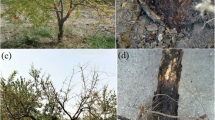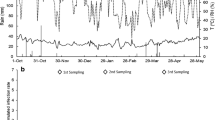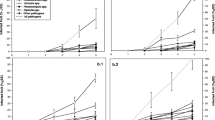Abstract
Fibulorhizoctonia psychrophila causes lenticel spot in stored pome fruit. A Dutch survey revealed that damage can be observed regularly in individual lots at low incidence to occasionally incidences above 25% after storage for five months or longer under specific controlled atmosphere storage conditions. The source of inoculum of the psychrophilic pathogen is not known. A species-specific TaqMan PCR assay was developed to quantify the pathogen DNA in orchard litter considered as potential inoculum source. 2008 samples of various litter types such as dead leaves, fallen fruits and mummies and necrotic tissues of grasses and weeds, collected in 2009–2012 in ten apple and twenty pear orchards, were analyzed. Although other fruit rot pathogens such as Neofabraea alba, Cadophora luteo-olivacea and Stemphylium vesicarium were detected in the samples at high incidences in earlier studies, F. psychrophila was only detected in three samples. The results show that F. psychrophila is not ubiquitously present in Dutch orchards at traceable concentrations. The main sources of the disease remain unknown. Possibly, the pathogen is present on storage bins or dust in storage facilities.
Similar content being viewed by others
Avoid common mistakes on your manuscript.
Various fungal pathogens can affect fruits of pear or apple in the orchard or later during storage causing spots or leading to fruit decay. Pathogens such as Neofabraea spp. (lenticel rot or bull eye’s rot), Neonectria ditissima (Nectria rot; blossom-end rot), Colletotrichum acutatum and C. gloeosporioides species complexes (bitter rot), Phytophthora spp., Alternaria spp., and Stemphylium vesicarium infect flowers or young fruits, remain latent and express symptoms late during storage (Wenneker & Thomma, 2020). These pathogens can cause significant losses during currently common storage conditions for up to 11 months under specific controlled atmosphere (CA) conditions, such as ultralow oxygen (ULO) and a dynamic controlled atmosphere (DCA) (Thewes et al., 2015; Van Schaik & Verschoor, 2003). A survey on postharvest diseases of stored apple and pear fruits in Dutch packinghouses in 2012–2016 revealed that the most important pathogen was Cadophora luteo-olivacea (Wenneker et al., 2021b). The study also showed that Fibulorhizoctonia psychrophila, a basidiomycete belonging to the Atheliales, caused lenticel spot on ‘Elstar’ apples (Fig. 1) and ‘Conference’ pears with an incidence ranging from very low to more than 25% (Wenneker et al., 2017). Recently, Jia et al. (2018) described a postharvest fruit rot on pear caused by Athelia bombacina and Ogoshi et al. (2021) a postharvest fruit rot in apple caused by Athelia sp. in Brazil, possibly similar or closely related to the anamorph F. psychrophila (Sulistyo et al., 2021).
Lenticel spot caused by Fibulorhizoctonia psychrophila in apple after seven month storage under specific controlled atmosphere. a Infected fruit cv. Elstar in a wooden storage bin; b Intense mycial growth between and on fruit cv. Elstar in a plastic storage bin; c Multiple lenticel spots on apple cv Elstar
In Dutch orchard studies in 2009–2012, N. alba, N. perennans, C. luteo-olivacea, C. malorum and S. vesicarium were quantified on litter using specific qPCR assays (Köhl et al., 2013, 2018). N. alba, C. luteo-olivacea and S. vesicarium were widely present in various necrotic host tissues of apple or pear as well as in dead residues of weeds or grasses, suggesting that litter potentially can be an important inoculum source of fruit rot diseases. For the newly described lenticel spot pathogen F. psychrophila (Wenneker et al., 2017), no information on its behaviour in orchards is available. The objective of our study was to obtain insight in possible inoculum sources of F. psychrophila.
Litter samples had been collected in Dutch orchards for studies on the role of necrotic host tissue such as dead leaves, fallen fruits and mummies, prunings, fruit spurs and cankers, and necrotic tissue of weeds and grasses as possible inoculum sources of brown rot in pear (2009–2011; ten pear orchards; Köhl et al., 2013) or post-harvest fruit rots in pear and apple (2012; ten pear orchards and ten apple orchards; Köhl et al., 2018). In the study conducted in 2012 also samples of top soil were included. Litter samples were freeze-dried, milled to fine powders and stored at -20 °C. DNA was extracted using the DNeasy 96 plant kit (Qiagen) (samples collected in 2009–2011) or the sbeadex maxi plant kit (samples collected in 2012) with several modifications.
A F. psychrophyla Taqman‐based real‐time PCR assay was developed based on the internal transcribed spacer (ITS) region. For this region sequences from NCBI were used to create an alignment of four different F. psychrophyla isolates and the closest related species with the software CLC genomics workbench 12.0 (CLC bio). Primers and probe were designed using Primer Express 3.0 (Thermo Fischer Scientific) and first analysed in silico for specificity using the NCBI BLAST feature (https://www.ncbi.nlm.nih.gov/BLAST). Secondly the specificity of the developed Taqman PCR assay was tested on synthetic oligonucleotides called gBlocks® (Integrated DNA Technologies), 250 bp long with in the central part the sequence of F. psychrophila targeted by the selected primers and probe or the sequence of the closest non-targets Athelia arachnoidea, A. bombacina and A. neuhoffii. Finally the primers and probe set was tested on 1 ng of genomic target or non-target DNA samples obtained from F. psychrophila isolates (Table 1) and 77 fungal isolates belonging to 29 non-target species used in an earlier study (Köhl et al., 2018).
Taqman PCR assays were performed in 384-well format (Köhl et al., 2018). For each TaqMan PCR assay, 1 μl sample was mixed with 9 μl reaction mix containing 5 μl 2X PerfeCTa qPCR Toughmix (Quantabio), 200 nM probe and 600 nM of each forward and reverse primer. For each 384 plate used a 10-fold serial dilution ranging from 1000 pg to 10–3 pg genomic DNA of F. psychrophila 45510 was run in parallel for reference. A separate Taqman PCR reaction with DNA (0.8 pg) encoding a green fluorescent protein (GFP) serving as an internal amplification control (AC) (Klerks et al., 2004) was performed for each sample. If measurements of the AC amplification indicated inhibition, measurements were repeated after 2-fold dilution of the sample.
The Taqman PCR assay with the designed forward primer CGGAGCCGTCCCATGC, reverse primer GCGGTTTTAAGGCGAGGATAT and MGB probe FAM-ACCCTGTATGTCATCAGA-BHQ1 was positive for all F. psychrophyla isolates tested. Genomic DNA or g-blocks of non-target fungi were not detected. The standard curve showed a linear dynamic range from 1000 pg to 10–3 pg (Fig. 2). Linear regression between the amount of F. psychrophyla (ng) and the corresponding Ct values revealed r2 of 0.985, while the mean efficiency of the Taqman PCR was 109% (n = 5). The detection limit of the qPCR is 1 fg. The AC indicated PCR inhibition for samples collected in 2009–2011. After a two-fold dilution of these samples there was no more inhibition observed. The Taqman PCR assay was applied to a total of 2008 samples in six separate runs. Average Ct value for the positive control (DNA of Fp at 1 ng concentration) was 18.14 with a standard deviation of 0.52 for the six runs (Table 2). Values for the negative control were always Ct > 40, the maximum cycles of a run.
Standard curve of F. psychrophyla genomic DNA log concentration against the cycle threshold (Ct) values. The concentration range was 1000 pg to 10–3 pg per reaction, each concentration tested in five-fold. Linear regression equation of the standard curve was Y = -3.12X + 36.980 at r2 = 0.985, efficiency was 109%
In 739 samples collected from February 2009 to May 2011 in two pear cv Conference orchards, F. psychrophila DNA was only detected in one sample of pruned annual wood sampled in Hansweert, the Netherlands, at 0.048 pg Fp DNA mg−1 substrate (dry weight). In 72 samples of crops residues of pear and dead weeds collected August 2009 in additional eight pear cv Conferences orchards, F. psychrophila DNA was not detected. Amongst 530 samples of various types of crop residues, or dead weeds or grasses collected in May 2012 in ten pear orchards and ten apple orchards, two samples contained detectable amount of F. psychrophila DNA. In a canker lesion from pear cv Conference, collected in Oosterhout, the Netherlands, 0.02 pg Fp DNA mg−1 substrate (dry weight) were quantified, in a fruit spur of apple cv Elstar, collected in Dreumel, the Netherlands, 0.007 pg Fp DNA mg−1 substrate (dry weight) were detected. In 667 samples collected in June to December 2012 in four apple orchards and in four pear orchards, F. psychrophila DNA was never detected.
The overall results of earlier assessments of the same samples showed that the fruit rot pathogens N. alba and C. luteo-olivacea are ubiquitously present in the Dutch orchards in litter whereas the fruit rot pathogens N. perennans and C. malorum were almost not detectable in the approximate 2000 samples of orchard litter (Köhl et al., 2013, 2018). These results are in line with the reported significant fruit rot losses during storage under specific controlled atmosphere for up to 11 months in the Netherlands caused by C. luteo-olivacea and N. alba but not by N. perennans and C. malorum (Wenneker et al., 2016, 2021a, b).
For F. psychrophila, it has been expected that, similar to the reported other fruit rot pathogens, orchard litter can serve as inoculum source of the lenticel spot disease, also because closely related fungi such as Athelia arachnoidea, A. bombacina and A. epiphylla have been described as colonizers and decomposers of deciduous leaves (Adams & Kropp, 1996). For another low-temperature basidiomycete causing post-harvest decay in apple and pear in cold storage in Northern America, associated with Coprinus psychromorbidus (Gaudet et al., 1990), Sholberg et al. (1998) demonstrated that the presence of litter on the orchard floor, especially of white clover, resulted in higher fruit rot incidences in storage. However, such a saprophytic colonization of orchard litter could not be confirmed by the results of the Taqman PCR assays. These unexpected results did not allow the identification of possible inoculum sources of the pathogen. Possibly, the pathogen is present in orchards at densities below the detection limit of the applied assay and such low densities are sufficient to cause lenticel infections. However, initial symptoms on affected fruits characteristically show dozens of discrete spots (Wenneker et al., 2017) suggesting that multiple infections per fruit are caused by spores present at high densities. Alternatively, pathogen inoculum causing infections is generally not present in sufficient densities in orchards but elsewhere. Given the late occurrence of symptoms during storage and the psychrophilic growth of the fungus (Wenneker et al., 2017), inoculum may be present and cause infections during long term cool storage in warehouses. Possibly, wooden boxes used for fruit storage can be colonized by F. psychrophila. Also Ogoshi et al. (2021) suggested wooden bins as main inoculum source of Athelia sp. fruit rot. However, recently, lenticel spot caused by Athelia sp. was observed on apples in plastic storage bins (Wenneker, unpublished). Other sources may be dusts of colonized organic material present in the storage operations. We hypothesize that mycelium of the psychrophilic pathogen is continuously growing during storage with a competitive advantage above less psychrophilic microorganisms at low rate, finally covering the apples (Fig. 1A-B). Subsequent infections occur by mycelium penetrating lenticels. This would explain the high number of lenticel spots of individual fruits that is commonly observed (Fig. 1C).
Further research is needed to identify or exclude such possible sources of inoculum as an important step towards management strategies preventing lenticel spot and fruit decay by F. psychrophila.
References
Adams, C., & Kropp, R. (1996). Athelia arachnoidea, the sexual state of Rhizoctonia carotae, a pathogen of carrot in cold storage. Mycologia, 88, 459–472.
Gaudet, D. A., Kokko, E. G., & Sholberg, P. L. (1990). Histopathology of apple fruit infected with strains of the low-temperature basidiomycete Coprinus psychromorbidus. Canadian Journal of Plant Pathology, 12, 369–375.
Jia, X.-H., Fu, J.-F., Wang, W.-H., Cui, J.-C., Du, Y.-M., Zhou, R.-J., & Sun, P.-P. (2018). First report of Athelia bombacina causing postharvest fruit rot on pear. Journal of Integrative Agriculture, 17, 2596–2599.
Klerks, M. M., Zijlstra, C., & van Bruggen, A. H. C. (2004). Comparison of realtime PCR methods for detection of Salmonella enterica and Escherichia coli O157:H7, and introduction of a general internal amplification control. Journal of Microbiological Methods, 59, 337–349.
Köhl, J., de Jong, P.-F., Kastelein, P., Groenenboom-de Haas, B. H., Anbergen, R. H. N., Balkhoven, H., & Wubben, J. P. (2013). Dynamics of pear-pathogenic Stemphylium vesicarium in plant residues in Dutch pear orchards. European Journal of Plant Pathology, 137, 609–619.
Köhl, J., Wenneker, M., Groenenboom-de Haas, B. H., Anbergen, R., Goossen-van de Geijn, H. M., Lombaers-van der Plas, C. H., Pinto, F. A. M. F., & Kastelein, P. (2018). Dynamics of post-harvest pathogens Neofabraea spp. and Cadophora spp. in plant residues in Dutch apple and pear orchards. Plant Pathology, 67, 1264–1277.
Ogoshi, C., Monteiro, F. P., Argenta, L. C., Pinto, F. A. M. F., Vieira, M., Cardoso, D. A., & Laube, N. (2021). First report of a postharvest fruit rot in apple caused by Athelia sp. in Brazil. Plant Pathology & Quarantine, 11, 108–114.
Sholberg, P. L., Hogue, E. J., & Neilsen, G. H. (1998). Effect of orchard cover crop on incidence of low-temperature basidiomycete rot of stored Spartan apples. Canadian Journal of Plant Science, 78, 125–129.
Sulistyo, B. P., Larsson, K.-H., Haelewaters, D., & Ryberg, M. (2021). Multigene phylogeny and taxonomic revision of Atheliales s.l.: Reinstatement of three families and one new family, Lobuliciaceae fam. nov. Fungal Biology, 125, 239–255.
Thewes, F. R., Both, V., Brackmann, A., Weber, A., & de Oliveira Anese, R. (2015). Dynamic controlled atmosphere and ultralow oxygen storage on ‘Gala’ mutants quality maintenance. Food Chemistry, 188, 62–70.
Van Schaik, A., & Verschoor, J. (2003). CA-storage: Technology, application and research. State of the art in the Netherlands. Acta Horticulturae, 600, 181–187.
Wenneker, M., & Thomma, B. P. H. J. (2020). Latent postharvest pathogens of pome fruit and their management: From single measures to a systems intervention approach. European Journal of Plant Pathology, 156, 663–681.
Wenneker, M., Pham, K. T. K., Lemmers, M. E. C., de Boer, F. A., van Leeuwen, P. J., Hollinger, T. C., Groenenboom-de Haas, B. H., & Köhl, J. (2016). First report of Cadophora luteo-olivacea causing side rot on ‘conference’ pears in the Netherlands. Plant Disease, 100, 2162.
Wenneker, M., Pham, K. T. K., Lemmers, M. E. C., de Boer, F. A., van Leeuwen, P. J., Hollinger, T. C., van de Geijn, F. G., & Thomma, B. P. H. J. (2017). Fibulorhizoctonia psychrophila is the causal agent of lenticel spot on apple and pear fruit in the Netherlands. European Journal of Plant Pathology, 148, 213–217.
Wenneker, M., Pham, K. T. K., & Köhl, J. (2021a). Important postharvest pathogens of pear and their dynamics in plant residues in Dutch pear orchards. Acta Horticulturae, 1303, 501–508.
Wenneker, M., Pham, K. T. K., Van Leeuwen, P. J., Van Schaik, A. C. R., & Köhl, J. (2021b). New and emerging postharvest diseases in pome fruit in the Netherlands. Acta Horticulturae, 1323, 143–149.
Acknowledgements
This research was funded by the Dutch Ministry of Agriculture, Nature and Food Quality and a consortium consisting of 13 companies lead by the Dutch Fruit Growers Organisation (NFO), and was part of the project KV 1605-032 ‘PPS Ontwikkelen van preventiemaatregelen in de boomgaard om verliezen door zwartvruchtrot in peer en appel te voorkomen’.
Author information
Authors and Affiliations
Corresponding author
Ethics declarations
Conflict of interest
The authors declare no conflict of interest and that the research complies with ethical standards. This research does not involve any human participants and/or animals.
Rights and permissions
Open Access This article is licensed under a Creative Commons Attribution 4.0 International License, which permits use, sharing, adaptation, distribution and reproduction in any medium or format, as long as you give appropriate credit to the original author(s) and the source, provide a link to the Creative Commons licence, and indicate if changes were made. The images or other third party material in this article are included in the article's Creative Commons licence, unless indicated otherwise in a credit line to the material. If material is not included in the article's Creative Commons licence and your intended use is not permitted by statutory regulation or exceeds the permitted use, you will need to obtain permission directly from the copyright holder. To view a copy of this licence, visit http://creativecommons.org/licenses/by/4.0/.
About this article
Cite this article
Köhl, J., Haas, B.H.Gd. & Wenneker, M. Fibulorhizoctonia psychrophila, causal agent of lenticel spot in pome fruit, rarely detected in Dutch pear and apple orchards. Eur J Plant Pathol 166, 285–289 (2023). https://doi.org/10.1007/s10658-023-02663-6
Accepted:
Published:
Issue Date:
DOI: https://doi.org/10.1007/s10658-023-02663-6






